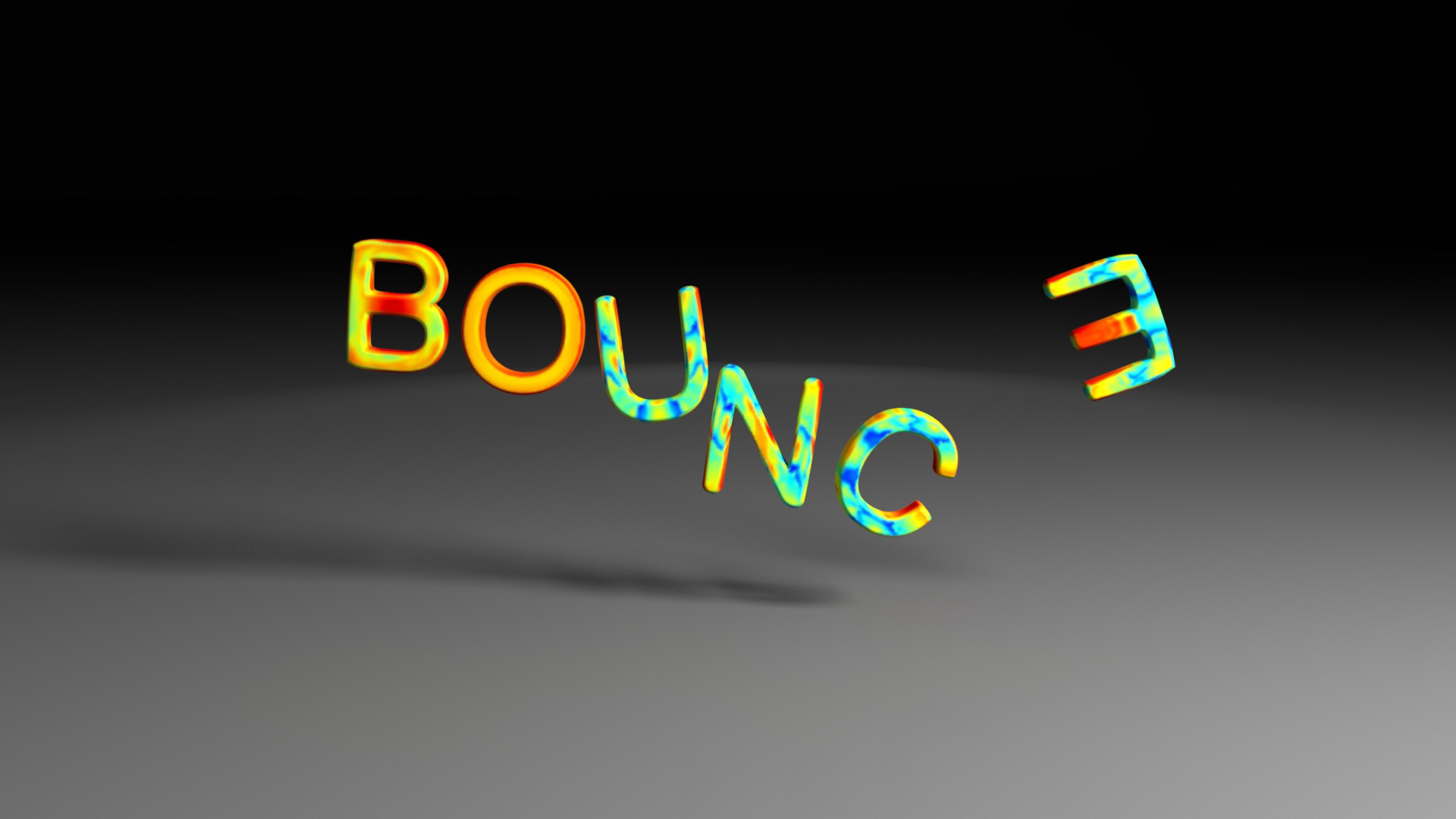“Bounce maps: an improved restitution model for real-time rigid-body impact”
Conference:
Type(s):
Title:
- Bounce maps: an improved restitution model for real-time rigid-body impact
Session/Category Title: Let's Get in Contact
Presenter(s)/Author(s):
Moderator(s):
Abstract:
We present a novel method to enrich standard rigid-body impact models with a spatially varying coefficient of restitution map, or Bounce Map. Even state-of-the art methods in computer graphics assume that for a single rigid body, post- and pre-impact dynamics are related with a single global, constant, namely the coefficient of restitution. We first demonstrate that this assumption is highly inaccurate, even for simple objects. We then present a technique to efficiently and automatically generate a function which maps locations on the object’s surface along with impact normals, to a scalar coefficient of restitution value. Furthermore, we propose a method for two-body restitution analysis, and, based on numerical experiments, estimate a practical model for combining one-body Bounce Map values to approximate the two-body coefficient of restitution. We show that our method not only improves accuracy, but also enables visually richer rigid-body simulations.
References:
1. David Baraff. 1997. An introduction to physically based modeling: Rigid body simulation II-Nonpenetration constraints. SIGGRAPH course notes (1997).Google Scholar
2. Ronen Barzel, John R Hughes, and Daniel N Wood. 1996. Plausible motion simulation for computer graphics animation. In Computer Animation and Simulation 96. Springer Vienna, 183–197.Google Scholar
3. Jan Bender, Kenny Erleben, and Jeff Trinkle. 2014. Interactive simulation of rigid body dynamics in computer graphics. In Computer Graphics Forum, Vol. 33. Wiley Online Library, 246–270. Google ScholarDigital Library
4. Bernard Brogliato. 2012. Nonsmooth mechanics: models, dynamics and control. Second edition. Springer Science & Business Media.Google Scholar
5. Anindya Chatterjee and Andy Ruina. 1998. A new algebraic rigid-body collision law based on impulse space considerations. Journal of Applied Mechanics 65, 4 (1998), 939–951. Google ScholarCross Ref
6. Stephen Chenney and D. A. Forsyth. 2000. Sampling Plausible Solutions to Multi-Body Constraint Problems. In Proceedings of SIGGRAPH 2000. 219–228. Google ScholarDigital Library
7. Antonio Doménech-Carbó. 2014. On the tangential restitution problem: independent friction-restitution modeling. Granular Matter 16, 4 (2014), 573–582. Google ScholarCross Ref
8. W. Goldsmith. 1960. Impact: The Theory and Physical Behaviour of Colliding Solids. Edward Arnold.Google Scholar
9. Doug L. James and Dinesh K. Pai. 2004. BD-Tree: Output-sensitive Collision Detection for Reduced Deformable Models. ACM Trans. Graph. 23, 3 (Aug. 2004), 393–398. Google ScholarDigital Library
10. Jingyi Jin, Michael Garland, and Edgar A. Ramos. 2009. MLS-based scalar fields over triangle meshes and their application in mesh processing. In Proceedings of the 2009 symposium on Interactive 3D graphics and games (I3D ’09). ACM, New York, NY, USA, 145–153. Google ScholarDigital Library
11. Danny M Kaufman, Shinjiro Sueda, Doug L James, and Dinesh K Pai. 2008. Staggered projections for frictional contact in multibody systems. In ACM Transactions on Graphics (TOG), Vol. 27. ACM, 164.Google ScholarDigital Library
12. Timothy R. Langlois, Steven S. An, Kelvin K. Jin, and Doug L. James. 2014. Eigenmode Compression for Modal Sound Models. ACM Trans. Graph. 33, 4, Article 40 (July 2014), 9 pages. Google ScholarDigital Library
13. Aurélien Martinet, Cyril Soler, Nicolas Holzschuch, and François X. Sillion. 2006. Accurate Detection of Symmetries in 3D Shapes. ACM Trans. Graph. 25, 2 (April 2006), 439–464. Google ScholarDigital Library
14. B. Mirtich and J. F. Canny. 1995. Impulse-based dynamic simulation of rigid bodies. In Symposium on Interactive 3D Graphics.Google Scholar
15. Carol O’Sullivan, John Dingliana, Thanh Giang, and Mary K Kaiser. 2003. Evaluating the visual fidelity of physically based animations. In ACM Transactions on Graphics (TOG), Vol. 22. ACM, 527–536.Google ScholarDigital Library
16. P. Painlevé. 1895. Sur les Lois du Frottement de Glissement. Comptes Rendus de l’Academie des Sciences 121 (1895).Google Scholar
17. Friedrich Pfeiffer and Christoph Glocker. 2008. Multibody Dynamics with Unilateral Contacts. John Wiley & Sons.Google Scholar
18. Jovan Popović, Steven M. Seitz, Michael Erdmann, Zoran Popović, and Andrew P. Witkin. 2000. Interactive Manipulation of Rigid Body Simulations. In Proceedings of SIGGRAPH 2000. 209–218. Google ScholarDigital Library
19. Ahmed A Shabana. 2012. Theory of Vibration: An Introduction. Springer Science & Business Media.Google Scholar
20. Ahmed A Shabana. 2013. Dynamics of multibody systems. Cambridge university press.Google Scholar
21. Breannan Smith, Danny M. Kaufman, Etienne Vouga, Rasmus Tamstorf, and Eitan Grinspun. 2012. Reflections on Simultaneous Impact. ACM Trans. Graph. 31, 4, Article 106 (July 2012), 12 pages. Google ScholarDigital Library
22. David E Stewart. 2011. Dynamics with Inequalities: impacts and hard constraints. SIAM.Google Scholar
23. Dan Stoianovici and Yildirim Hurmuzlu. 1996. A Critical Study of the Applicability of Rigid-Body Collision Theory. Journal of Applied Mechanics 63, 2 (1996), 307.Google ScholarCross Ref
24. William James Stronge. 2004. Impact mechanics. Cambridge University Press.Google Scholar
25. Christopher D. Twigg and Doug L. James. 2007. Many-Worlds Browsing for Control of Multibody Dynamics. ACM Transactions on Graphics 26, 3 (July 2007), 14:1–14:8.Google ScholarDigital Library
26. C Ullrich and Dinesh K Pai. 1998. Contact response maps for real time dynamic simulation. In Robotics and Automation, 1998. Proceedings. 1998 IEEE International Conference on, Vol. 3. IEEE, 1950–1957.Google ScholarCross Ref
27. C Ullrich and Dinesh K Pai. 1999. Green’s function contact maps for accurate real time collisions. In Robotics and Automation, 1999. Proceedings. 1999 IEEE International Conference on, Vol. 3. IEEE, 1849–1855.Google ScholarCross Ref
28. Yu Wang and Matthew T. Mason. 1987. Modeling Impact Dynamics for Robotic Operations. In Proceedings of the IEEE International Conference on Robotics and Auutomation. 678–685. Google ScholarCross Ref
29. Changxi Zheng and Doug L. James. 2011. Toward High-Quality Modal Contact Sound. ACM Transactions on Graphics (Proceedings of SIGGRAPH 2011) 30, 4 (Aug. 2011). http://www.cs.cornell.edu/projects/Sound/mcGoogle Scholar





